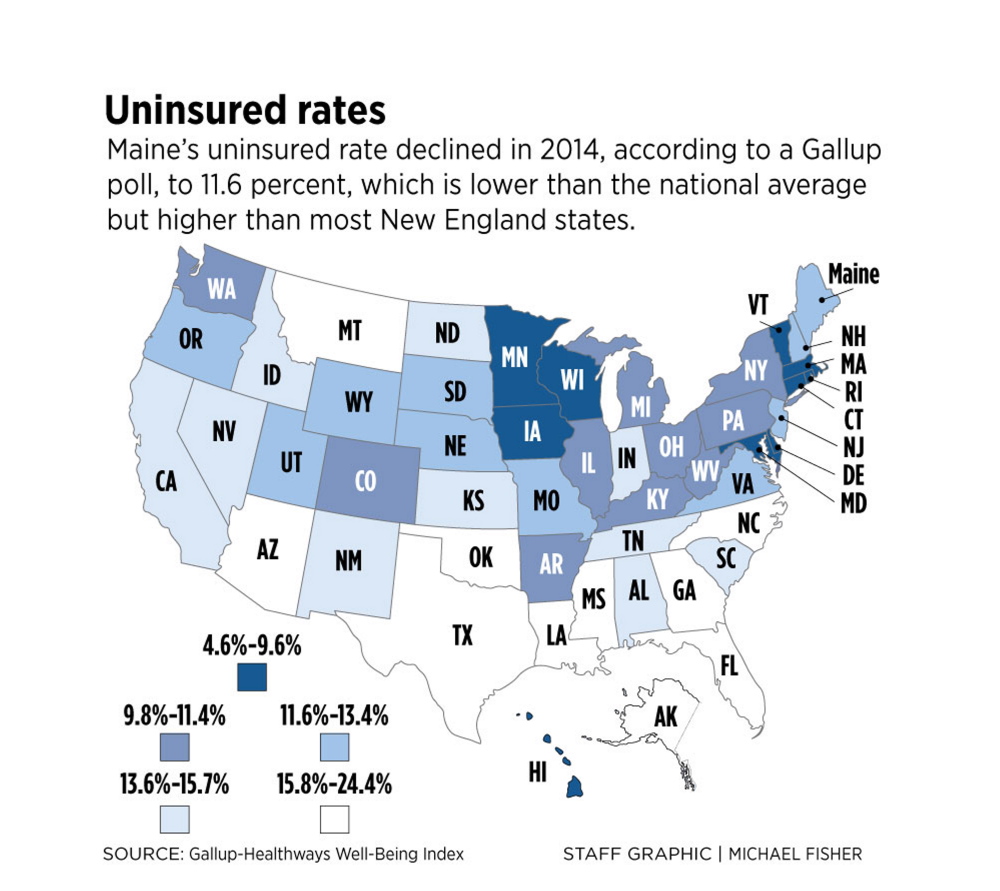Maine’s uninsured rate dropped by more than one-fourth in 2014, the first full year that subsidized benefits were available through the Affordable Care Act, according to a Gallup poll released Tuesday.
The number of uninsured among Maine’s roughly 1.1 million adults declined from 16.1 percent in 2013 to 11.6 percent in 2014, the national polling firm said.
Nationally, the number fell from 17.3 percent to 13.8 percent of the population.
The poll captured results for the first full year that the Affordable Care Act’s marketplace was in effect. Gallup interviewed people from January through December 2014 and compared the results with surveys during the same time frame for 2013.
People could begin signing up for ACA benefits starting in October 2013, for coverage that began in January 2014. The subsidized benefits are available to those who earn between 100 percent and 400 percent of the federal poverty level and can’t get coverage through an employer. Many are self-employed or part-time workers.
One of the newly insured was Lisa Mae Parker, 54, of Parsonsfield, who obtained ACA coverage in 2014 so she could start her cake decorating business.
“I feel like (the ACA) has really helped people,” Parker said. “I’d much rather know my neighbors have coverage and are taken care of.”
The 4.5 percentage-point drop in 2014 still left about 125,000 adults in the state without health insurance. All of Maine’s children are insured, either through private insurance or MaineCare.
Although Maine’s uninsured rate is lower than the national average, it is higher than all of the other New England states except for New Hampshire, where 12.8 percent of the population lacks insurance. At 4.6 percent, Massachusetts, which created a similar health insurance system in 2006 under former Gov. Mitt Romney, has the fewest uninsured residents.
“This shows that people really value insurance,” said Emily Brostek, executive director of Augusta-based Consumers for Affordable Health Care, a nonprofit specializing in health policy. “But when we look to our neighbors, Maine is still lagging behind.”
MEDICAID EXPANSION, OTHER FACTORS PLAY ROLE
Although New Hampshire currently has a higher percentage of uninsured than Maine, that may not be the case in upcoming years because New Hampshire recently agreed to expand Medicaid under a compromise plan crafted by Democratic Gov. Maggie Hassan and a bipartisan group of state lawmakers. Medicaid expansion is a key component of how the law reduces the rolls of the uninsured, but a U.S. Supreme Court decision in 2012 changed Medicaid expansion from mandatory for the states to voluntary.
Maine Gov. Paul LePage has vetoed several attempts to participate in the voluntary Medicaid expansion, arguing that the state cannot afford the cost of expansion.
The states with the lowest uninsured rates – including Massachusetts, Connecticut and Minnesota – have all expanded Medicaid, according to the Gallup poll.
Brostek said the uninsured rate’s significant decline is an indication that many who are signing up were previously uninsured, as opposed to people simply switching from a previous plan to the ACA.
The rebounding economy, people securing health benefits through an employer, and health-care advocates’ grass-roots efforts to sign up Mainers for ACA coverage also could have played roles in the decline, said Mitchell Stein, a Cumberland-based health policy analyst.
Fifty-three percent of those eligible for marketplace coverage had signed up in Maine through this year’s Feb. 15 deadline, far above the national average of 37 percent, according to the Kaiser Family Foundation.
Stein said many of the states that did not expand Medicaid have much higher uninsured rates than Maine.
“Maine was starting off from a much better place,” Stein said. For instance, Montana, which did not expand Medicaid, saw its uninsured population decline from 20.7 to 15.8 percent.
SWITCH TO ACA COVERAGE HAS DRAWBACKS
When Maine trimmed the Medicaid rolls by tightening eligibility, the number of Mainers who have Medicaid declined from 367,000 to 290,000, according to the LePage administration. Maine’s uninsured rate increased from 14.8 in 2012 to 16.1 in 2013, before the decline to 11.6 percent in 2014.
That’s an indication that many who were kicked off of Medicaid purchased ACA insurance, a fact often highlighted by the LePage administration. Maine Republicans encouraged people who had lost Medicaid coverage to apply for ACA insurance on healthcare.gov.
Stein said that although it’s good that many had the option to purchase marketplace insurance, using that insurance for more than preventive screenings could prove difficult.
“If you’re living on the financial edge, you’re one appendectomy away from being bankrupt,” Stein said, explaining that an expensive medical procedure, even for the insured, can result in thousands owed for deductibles and co-payments.
But Dr. Dora Anne Mills, vice president for clinical affairs at the University of New England, said the drop in the uninsured rate should help control overall health care costs.
“Lack of access is one of the major barriers to receiving health care. If you’re afraid of the bill, you’re not going to seek care,” Mills said. “You are going to have stability in the health care industry and a healthier population.”
Joe Lawlor can be contacted at 791-6376 or at:
jlawlor@pressherald.com
Twitter: joelawlorph
Send questions/comments to the editors.






Comments are no longer available on this story